Ge
-
- Sizing Up the Market, Scaling Solutions to Size Marine News, Jul 2017 #38
GE Dips its toes in inland waters with its compact and easy to install Tier IV EGR solution
In October of 2014, news of Oceaneering’s purchase of GE Transportation’s newest marine engine offering was making waves. These engines – ones which meet EPA Tier 4i and IMO Tier III Emissions standards – without the need for a Selective Catalytic Reduction system (SCR) exhaust gas after-treatment, had workboat operators everywhere looking at new possibilities. Before that, Harvey Gulf International Marine also entered into a contract to construct a new Multipurpose Field Support Vessel (MPFSV) at Eastern Shipbuilding, this one also powered by GE’s Tier 4 compliant, EGR main engines. That’s important because Harvey Gulf, the recognized North American leader in rolling out LNG and dual fuel propulsion vessels, in this case, selected a pure diesel engine.Fast ForwardTwo years later, more compact versions of the environmentally advanced engines have been introduced to the inland and workboat sectors. Until recently, the repower or rebuild quandary was largely a question of whether to go with diesel and SCR, dual fuel and/or pure gas engines. As mid-year 2017 approaches, vessel operators in virtually every category have a new choice to consider when it comes to newbuild or repower decisions. The GE Marine 12V250 Marine diesel engines reduced NOx emissions by 70 percent when compared to EPA Tier 2 or IMO Tier II. Common rail fuel injection provides better fuel atomization through a high-pressure fuel rail feeding solenoid valves instead of individual high-pressure fuel pumps feeding individual injector units. This injection method also allows for better control of injection timing over the entire operating range. Exhaust Gas Recirculation lowers NOx emissions by cooling, mixing, and recirculating a portion of the exhaust gas with incoming air to reduce stack emissions. This method is self-contained within the engine.Beyond this, GE Marine’s self-described ‘breakthrough’ engine technology not only eliminates the need for SCR, but all of the extra costs associated with that extraneous equipment. Now, that option also comes in both 6L and 8L versions.Operators tempted by the LNG route still must decide whether the present infrastructure – and that which is promised – will materialize and if so, will be adequate to their requirements. For others, the answer, until just recently, was quite clear: eventually you’d need SCR. And in the case of both LNG and SCR assisted diesel arrangements, operators were looking at large infrastructure installs and the potential loss of deadweight and/or capacity. Not anymore, says GE.GE Engines are offered for direct mechanical propulsion or as gensets for diesel-electric propulsion.GE’s Newest Marine Engines – up close and personalIn a late May, Marine News and Hatton Marine’s Thor Hatton and Matt Zeitz toured the GE Marine Engine production facility located in Grove city, PA. Employing 500, GE produces three Tier 4 compliant, EGR solution marine engines here. Seattle-based Hatton Marine, an engine distribution shop providing both service and installation work, partners with many OEM’s, none more important at this time than GE Marine. Firm believers in the GE EGR solution, they’ve gotten in on the ground floor with GE, and are now actively planning and taking orders for the simple Tier 4 solution.For Thor Hatton, sales will never be Hatton Marine’s main focus. That said; and with so many different lines to choose from, Hatton Marine will always sell the customer what they want and what is best for their application. For example, Hatton represents Brunvoll-Volda Propulsion, allowing Hatton to offer a complete, turn-key propulsion package along with the GE engine, whether conventional, diesel-electric or in a number of different configuration options. Following every engine from cradle to grave, Hatton provides, 24/7/365, worldwide, the following services:- Sale of an engine;
- Installation and commissioning;
- Fabrication of engine room exhaust and piping;
- Gear and drive line sale and installation
- Generator sale and installation
- Service support over the life of all those products
The GE Tier 4 solution has gained considerable traction in the past three years, and sales of the 6L and 8L versions – those suited to smaller workboats – are eclipsing the sales of the larger engines. This is hardly GE’s first rodeo with Tier 4. With more than 850 Tier-4 compliant locomotive engines already in service, GE’s marine sector offerings are based on a proven, time-tested concept. Hatton told Marine News in May, “The 250 series marine engine is based on the GE Evolution or ‘EVO’ locomotive engine which was originally a 12 cylinder V engine. A few years ago GE developed an inline 6 and inline 8 engine based on the same 250mm bore engine platform. Typically this has been used in tugs, ATB’s, fishing vessels.”The most immediate impact of Tier 4 regulations to the maritime industry is with new construction vessels, but that hasn’t stopped Ingram from plans to repower at least three of their workboats with the GE tier 4 solution.Decisions: Data DrivenIt can be a difficult decision for any operator to decide how, when and which propulsion option to select. These choices include so-called ‘tier beaters,’ LNG, dual fuel and of course, Tier 4 compliant SCR solutions. Hatton’s Matt Zeitz answered that question with one of his own, saying, “One of the questions that I am frequently asked is ‘Why is GE the only one using this technology?’ The answer is that GE already had a large market for the Tier 4 engine platform due to their position in the railroad industry which allowed them to make the significant investment it took to develop the technology. Rail operators required a solution that was compact enough to fit within a locomotive car body, and that did not use urea to achieve emissions compliance.”The new GE Tier 4 engine is larger and heavier. Based on GE data, the weight increased by 9 percent and engine room space consumed increased by 12 percent. That increased size could also involve increased engine foundation strength. The GE 8L250 is nominally heavier than the CAT 3516 (not surprising comparing medium speed to high speed engines – see table 5), but, says Hatton, “There’s no comparison when you consider the added weight of the aftertreatment system and urea.”On any workboat, however, space is always a concern. GE’s Tier 4 engine has increased incrementally in weight and volume, but the footprint is essentially the same as a Tier 2/3 engine. Using SCR, a line haul tug or fishing vessel would need to carry a significant volume of urea compared to, say a harbor tug. Hatton adds, “Many of our customers operate in remote areas of Alaska for extended periods of time, or tow back and forth to Hawaii. Logistically, supplying DEF to vessels in these areas could be difficult.”From an OpEx perspective, the GE Tier 4 engine requires no additional maintenance, and there is no interval for a ‘top end’ overhaul. Hatton continues, “Certain components of the SCR system will require maintenance or replacement ahead of a typical engine overhaul cycle – pump, dosing injector, the catalyst itself.”Separately, an operator must consider fuel consumption. An industry analysis report comparing the GE solution to the SCR solution showed that the overall fluid consumption for the SCR solution was about equal between their Tier 2 and Tier 4 engines; expected fuel savings combined with increased urea cost was a ‘wash.’ Hence, for a comparable Caterpillar Engines, for example, it is not any more expensive to operate the C280 Tier 4 than the C280 Tier 2 engine.Conversely, GE has shown that their Tier 4 engines have achieved lower fuel consumption compared to the Tier 2 product. Since no urea is used, overall fluid consumption is lower. According to GE, the EGR impact to fuel consumption will be slightly better than the Tier 2 engine solution, providing potential savings.The GE solution has the least amount of impact to the vessel. SCR solutions, in contrast, constitute significant impact to vessel design. For GE’s EGR version, the only significant non-engine component that will need to be addressed is the shipyard supplied engine cooling system, which will need to reject more heat due to the addition of cooling for exhaust gas recirculation. DEF storage for SCR solutions, on the other hand, could be reduced depending on voyages, plans, logistics and operator preference. At the same time, and depending of the arrangement of the DEF storage, cargo fuel storage capacity may be displaced to allow room for DEF storage.Zeitz points out that the SCR solution is unstable at extreme temperatures, and at least in the short term the market for it would be limited, especially in remote areas. In May, Jensen’s Johan Sperling told Marine News, “A lot of people don’t like urea – I don’t blame them. The after treatment system can be large, it is warm; it has all kinds of things that we’re not used to.” That’s because Urea is caustic, creating a highly corrosive environment. For example, if freezing is a concern, additional tank and blanket heating might be needed. Conversely, if temperatures rise above 122°F (50°C), ammonia is formed, causing degradation of the DEF solution. After 6 days of being stored at 122°F (50°C) or greater, the maximum limit of ammonia is exceeded. Therefore, a cool, well-ventilated DEF storage should be considered.On the Water, NowBob Dorn owns and leases out three tugboats that collectively employ a total of eight, inline 8 GE engines. The Hatton Marine client was effusive in his praise of the GE brand, saying, “The more I dove into it, GEs were by far the best choice. When we were going through this process (Engine selection for his new builds) fuel was at four dollars a gallon, and the engines that I’ve operated for over 30 years burn about 5,000 gallons a day. I was hoping to burn 4,000 gallons a day with GE, and at 4 dollars a gallon I figured that’s a great savings—we can save $4,000 a day. It turns out that instead of 4,000 gallons a day they were burning 2,700 gallons a day. That meant a savings of $10,000 dollars a day on fuel, and you have these vessels for 30 to 40 years that’s an amazing savings over time.”Dorn touches upon one additional (perhaps unexpected) benefit of the GE engines. He explains, “The Coast Guard has done lots of studies on crew fatigue and one of the outcomes of that is a lower frequency sound is easier to live with so everybody loves working on a GE engine boat as opposed to high speed or two stroke engine vessels. I’ve been happy with the decision we made (GE engines) and the customers we have like them a great deal.”An extensive test cell at the Grove City plant verifies the performance and compliance of each engine, before it is shipped. In GE’s locomotive sector, that engine performance is monitored in real time continuously and that same advantage is being developed and discussed for GE’s marine engines, as well. At that point, the proven utility of this Tier 4 solution might be as common as the 850+ GE locomotive engines, from which this marine offering emanated. In the meantime, Tier 4 compliance just got a little easier; in the yard, on the water, and beyond.(As published in the July 2017 edition of Marine News) -
- Standing on Guard(eon): Preventing the ‘Arc Flash’ Casualty Maritime Reporter, Aug 2015 #70
As GE celebrates the grand opening of its Mebane Customer Experience Center and a multimillion dollar manufacturing facility renovation, Maritime Reporter & Engineering News gets an advance look at a new product line that could save marine and oil and gas customers millions of dollars in lost time and
-
- GE M&SP Makes Strong Maritime Push Maritime Reporter, Jan 2004 #38
GE Transportation Systems. Marine & Stationary Power (M&SP). is making a strong push to capture medium-speed diesel engine business in the maritime sector, fortifying an international network of service centers and bringing its product to center stage at many of the Autumn 2003 trade exhibition.
-
- Marine Engine Emissions: GE Changes the Conversation Maritime Logistics Professional, Q4 2014 #33
As operators ponder the thorny question of dual fuel, LNG or SCR Treatment, GE Transportation’s new medium speed marine diesel engine seemingly simplifies the playing field. Current Events, Futuristic Propulsion The October 2014 news that global oilfield giant Oceaneering had committed to building a
-
- Engine Emissions: GE Changes the Conversation Maritime Logistics Professional, Q4 2014 #33
As operators ponder the thorny question of dual fuel, LNG or SCR Treatment, GE Transportation’s new medium speed marine diesel engine seemingly simplifies the playing field. Current Events, Futuristic Propulsion The October 2014 news that global oilfield giant Oceaneering had committed to building a ship
-
- Talking Turbines with Bolsinger, VP at GE Marine Maritime Reporter, Nov 2014 #134
As the commercial marine market faces increasingly stringent propulsion system emission restrictions and fuel cost pressures, propulsion technologies such as gas turbines can gain traction in more mainstream commercial applications. Maritime Reporter & Engineering News recently spent some time with Brien
-
- Making the Mark For Crescent Towing's Fleet Maritime Reporter, Nov 2004 #40
The first GE Diesel engine in Crescent Towing's fleet went into service in 1971 powering the retrofitted Port Hudson tug — a retired U.S. Navy tug. The Port Hudson is still operating today using a GE medium-speed diesel engine. "I've worked for Crescent Towing for 24 years, and the GE engines are the
-
- GE LM2500s Slated For Norwegian Frigates Maritime Reporter, Jan 2002 #31
GE Marine Engines said its LM2500 aeroderivative gas turbine will power five new Royal Norwegian Navy F310-class frigates, ships to be built in Spain at the IZAR Construcciones Navales, S.A., naval shipyard in Ferrol. This is the first naval Combined Diesel And Gas Turbine (CODAG) configuration to be
-
- As Banks Step Down, Equipment Finance Companies Step Up Maritime Reporter, Apr 2002 #44
distinct differences of opinion, but the one thing that all agree on is the importance of having access to capital. In an industry in which assets are generally bigticket items and operating margins can be thin, access to proper financing serves the dual purposes of fleet growing the generation of
-
- Gas Turbines: Keeping Fresh With Innovation Maritime Reporter, May 2004 #32
Keeping pace with the fast-evolving maritime industry is a mantra at GE Marine with its LM aeroderivative gas turbine line. Going forward, GE Marine will see its LM gas turbines applied in several novel and state-of-the-art military and commercial marine projects. One military application in particular
-
- MN100: GE Transportation Marine Marine News, Aug 2016 #26
The Company: GE Transportation is a global digital industrial leader and supplier to the marine industry. Established more than a century ago, GE Transportation is a division of the General Electric Company that began as a pioneer in passenger and freight locomotives. That innovative spirit still drives GE
-
- The ABC’s of DP 101 Marine News, Sep 2019 #44
to critical offshore operations and vessel handling, this is not your grandfather’s marine industry, and it hasn’t been for some time. That’s because the bridge layout and equipment commonly found on any recently delivered offshore service vessel would be unfamiliar to the typical deck officer of just 20 years
-
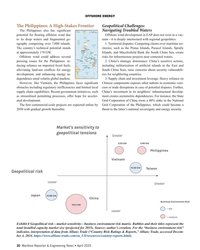 )
April 2025 - Maritime Reporter and Engineering News page: 30
)
April 2025 - Maritime Reporter and Engineering News page: 30OFFSHORE ENERGY T e Philippines: A High-Stakes Frontier Geopolitical Challenges: Navigating Troubled Waters The Philippines also has signi? cant potential for ? oating offshore wind due Offshore wind development in EAP does not exist in a vac- to its deep waters and fragmented ge- uum—it is deeply
-
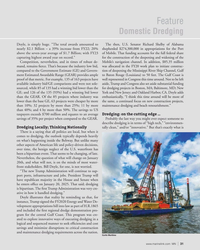 )
January 2025 - Marine News page: 31
)
January 2025 - Marine News page: 31Feature Domestic Dredging Doyle, is simply huge. “The total awards amounted to The then, U.S. Senator Richard Shelby of Alabama nearly $2.1 Billion – a 39% increase from FY22; 20% shepherded $274,300,000 in appropriations for the Port above the seven-year average of $1.7 Billion; with FY23 of Mobile.
-
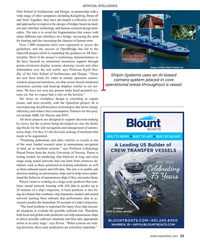 )
December 2024 - Maritime Reporter and Engineering News page: 23
)
December 2024 - Maritime Reporter and Engineering News page: 23ARTIFICIAL INTELLIGENCE Oslo School of Architecture and Design, in partnership with a wide range of other companies including Kongsberg, Brunvoll and Vard. Together, they have developed a collection of tools and approaches to improve the design of bridges based on mod- ern user interface technology and
-
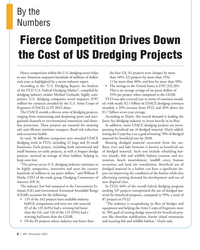 )
November 2024 - Marine News page: 8
)
November 2024 - Marine News page: 8By the Numbers Fierce Competition Drives Down the Cost of US Dredging Projects Heavy competition within the U.S. dredging sector helps the base GE, 63 projects were cheaper by more to save American taxpayers hundreds of millions of dollars than 10%; 32) projects by more than 25%; each year, as
-
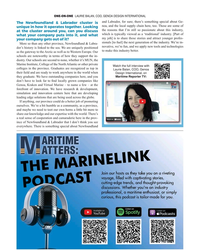 )
November 2024 - Maritime Reporter and Engineering News page: 24
)
November 2024 - Maritime Reporter and Engineering News page: 24ONE-ON-ONE LAURIE BALAN, COO, GENOA DESIGN INTERNATIONAL and Labrador, for sure; there’s something special about Ge- The Newfoundland & Labrador cluster is noa, and the local supply chain here, too. Those are some of unique in how it operates together. Looking the reasons that I’m still so passionate
-
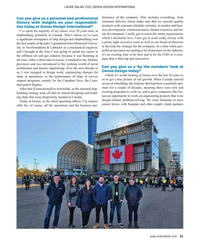 )
November 2024 - Maritime Reporter and Engineering News page: 21
)
November 2024 - Maritime Reporter and Engineering News page: 21LAURIE BALAN, COO, GENOA DESIGN INTERNATIONAL formance of the company. That includes everything, from Can you give us a personal and professional customer delivery where make sure that we execute quality history with insights on your responsibili- products with constant schedule certainty, to market and
-
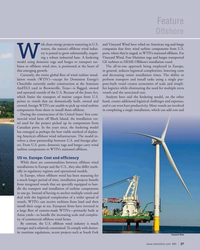 )
October 2024 - Marine News page: 27
)
October 2024 - Marine News page: 27Feature Offshore ith clean energy projects maturing in U.S. and Vineyard Wind have relied on American tug-and-barge waters, the nation’s offshore wind indus- companies that ferry wind turbine components from U.S. try is poised to grow substantially, requir- ports, where they’re staged, to WTIVs stationed
-
 )
September 2024 - Maritime Reporter and Engineering News page: 16
)
September 2024 - Maritime Reporter and Engineering News page: 16Cable and ZTT have shore wind development are found in Europe also supplied European projects. Of particular note, where (and Europe will remain the largest overall the three dominant western turbine OEMS (Vestas, Siemens W regional market for offshore wind activity in and GE) are focusing efforts on
-
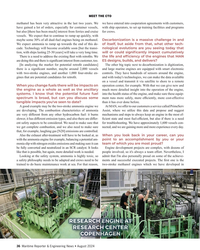 )
August 2024 - Maritime Reporter and Engineering News page: 36
)
August 2024 - Maritime Reporter and Engineering News page: 36. We expect that to continue to ramp up quickly, with maybe some 30% of all dual-fuel engines being on methanol. Decarbonization is a massive challenge in and We expect ammonia to ramp up towards the end of this de- of itself, but aside from that, what other tech- cade. Technology will become available
-
 )
August 2024 - Maritime Reporter and Engineering News page: 35
)
August 2024 - Maritime Reporter and Engineering News page: 35R R R R R R R R R R R R R R RG G G G G G G G G G G G G, , , , , , , , , , , , , , , , , , , , , , , , , G G G G G G G G G G G G G G G G G G G G G G G G G G G GE E E E E E E E E E E E E E ER R R R R R R R R R R R R R R R R R R R R R R R R R R RM M M M M M M M M M M M M M M M M M M M M M M M MA A A A A A A A A
-
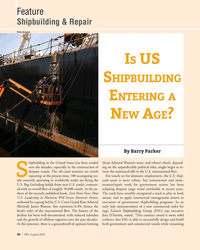 )
August 2024 - Marine News page: 30
)
August 2024 - Marine News page: 30Feature Shipbuilding & Repair Philly Shipyard I US S HIPBUILDING S E NTERING A EW GE N A ? By Barry Parker hipbuilding in the United States has been eroded (from Admiral Watson’s team, and others) which, depend- over the decades, especially in the construction of ing on the unpredictable political
-
 )
April 2024 - Maritime Reporter and Engineering News page: 16
)
April 2024 - Maritime Reporter and Engineering News page: 16bases to offshore wind farms 12-24 and increasingly 30+ technicians on a daily basis and for construction and O&M activities: crew transfer have an advantage when windfarms are close to shore. There A vessel (CTV), helicopter, and SOVs/CSOVs. is a trend for CTVs to be built with crew accommodation, SOVs
-
 )
March 2024 - Marine Technology Reporter page: 23
)
March 2024 - Marine Technology Reporter page: 232014, the Hunga Tonga–Hunga Ha‘apai (HT-HH) submarine volcano began erupting on December 20, 2021, reaching peak intensity on January 15, 2022. This triggered tsunamis throughout the Pa- R ci? c, destroyed lives and infrastructure, and generated the largest explosion recorded by modern instrumentation
-
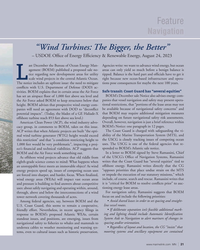 )
April 2024 - Marine News page: 21
)
April 2024 - Marine News page: 21Feature Navigation “Wind Turbines: The Bigger, the Better” – USDOE Of? ce of Energy Ef? ciency & Renewable Energy, August 24, 2023 ast December the Bureau of Ocean Energy Man- Agencies write: we want to advance wind energy, but ocean agement (BOEM) published a proposed sale no- areas can only yield so
-
 )
February 2024 - Maritime Reporter and Engineering News page: 44
)
February 2024 - Maritime Reporter and Engineering News page: 44Tech Files Latest Products & Technologies MarineShaft Yanmar Hydrogen MarineShaft specializes in urgent re- Fuel Cell AIP pair/replacement of damaged rudder and Yanmar Power Technology Co., Ltd. propeller equipment along with many (Yanmar PT), a subsidiary of Yanmar on-site repair services. MarineShaft
-
 )
February 2024 - Maritime Reporter and Engineering News page: 22
)
February 2024 - Maritime Reporter and Engineering News page: 22R&D MATT HART Matt Hart, Manager & Platform Leader, Marine & Stationary Power Systems, Wabtec, offers insights on how the megatrends of decarbonization, energy transition and autonomy all inspire Image courtesy Wabtec and impact the marine power solutions from Wabtec. By Greg Trauthwein Matt, to start
-
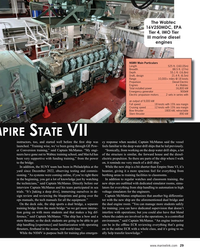 )
December 2023 - Maritime Reporter and Engineering News page: 29
)
December 2023 - Maritime Reporter and Engineering News page: 29marine diesel engines NSMV Main Particulars Length 525 ft. (160.05m) Breadth 88.5 ft. (27m) Depth 55.1 ft. (16.8m) Draft, design 21.4 ft. (6.5m) Range 10,000+ miles @ 18 knots Propulsion Diesel Electric Engines 4 x Wabtec Total installed power 16,800 kW Emergency generator 900kW Electric propulsion
-
 )
December 2023 - Maritime Reporter and Engineering News page: 28
)
December 2023 - Maritime Reporter and Engineering News page: 28VII is the ? rst in a series of ? ve Na- that there are two separate engine rooms with a pair of diesel tional Security Multi-Mission Vessel (NSMV), generators in each, both feeding dual high voltage switch- built at Philly Shipyard, powered by Wabtec Tier boards and dual propulsion motors. VI diesel
-
 )
November 2023 - Marine News page: 49
)
November 2023 - Marine News page: 49rier islands and nourishing beaches an electrical power, propulsion, and building Group (ESG) this Spring de- lost to erosion, aiding the U.S. Army dredge machinery package by Royal livered R.B. Weeks, a 8,550 cubic yard Corps of Engineers and other key cli- IHC. It is equipped with twin Wabtec capacity
-
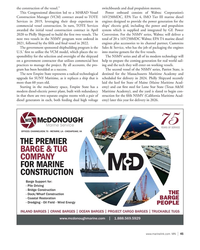 )
November 2023 - Marine News page: 45
)
November 2023 - Marine News page: 45switchboards and dual propulsion motors. This Congressional direction led to a MARAD Vessel Power onboard consists of Wabtec Corporation’s Construction Manager (VCM) contract award to TOTE 16V250MDC, EPA Tier 4, IMO Tier III marine diesel Services in 2019, leveraging their deep experience in engines designed
-
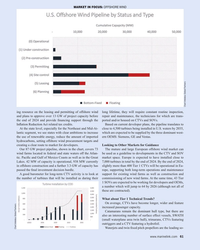 )
November 2023 - Maritime Reporter and Engineering News page: 61
)
November 2023 - Maritime Reporter and Engineering News page: 61to increase which are expected to be supplied by the three dominant west- the use of renewable energy, reduce the amount of imported ern OEMS: Siemens, GE and Vestas. hydrocarbons, setting offshore wind procurement targets and creating a clear route to market for developers. Looking to Other Markets for
-
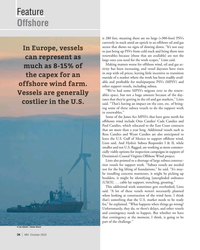 )
October 2023 - Marine News page: 34
)
October 2023 - Marine News page: 34Feature Offshore is 280 feet, meaning there are no large (+300-foot) PSVs currently in stack amid an uptick in an offshore oil and gas sector that shows no signs of slowing down. “It’s not easy I I In n n n n E E E E Eu u u ur r r ro o o o op p p p p p pe e, , , v ve e es s s ss s s s se e e el l l ls s
-
 )
September 2023 - Maritime Reporter and Engineering News page: 30
)
September 2023 - Maritime Reporter and Engineering News page: 30, has drawn a broad cadre of suppliers. The powerplant was a main focus, helping to evolve the schools from steam power plants to a modern propulsion package. By Greg Trauthwein SMVs being built for the maritime academies is Wabtec has built thousands of tier four diesel engines for trains, widely lauded
-
 )
September 2023 - Maritime Reporter and Engineering News page: 27
)
September 2023 - Maritime Reporter and Engineering News page: 27CAPTAIN MORGAN MCMANUS modern diesel-electric power plant, built with redundancy in that there are two separate engine rooms with a pair of diesel generators in each, both feeding dual high voltage switch- boards and dual propulsion motors. “It’s built from a redundancy for the safe return to port
